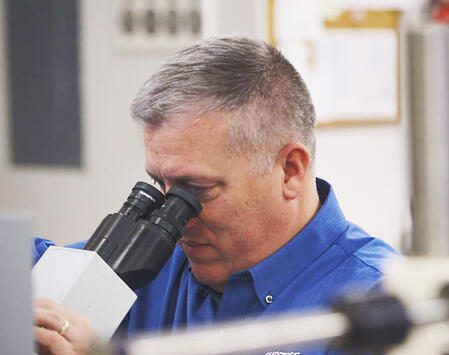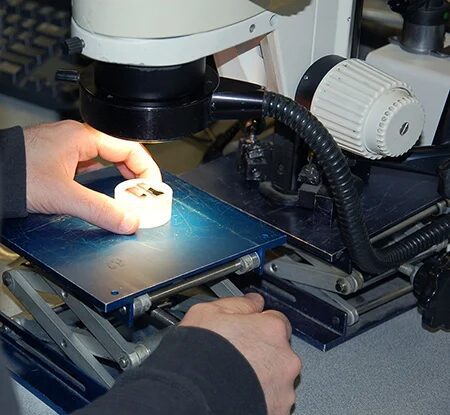MICROSTRUCTURAL METAL ANALYSIS SERVICES
Metals and alloys can be microstructurally tested in order to determine physical properties such as strength, toughness, ductility, corrosion susceptibility, and wear resistance. Understanding the physical properties of the metal or alloy indicates whether the material will be applicable in manufacturing and production designs. Additionally, whether materials are processed correctly will be indicated through metal analysis. These analytical methods provide a baseline criteria for root cause analysis, in order to determine a reliable metal or alloy choice, with little chance of product failure.
Metal Analysis Observational Categories
When performing microstructural analysis services, there are several observational categories that help identify a metal or alloys composition and thermomechanical history. Among these are:
Grain Size
Grain size is the size of individual grains, which influences hardness, material strength, mechanical properties of metal.
Phase Analysis
Phases are regions with different chemical compositions or crystal structures. Phase transformations, distribution, and specificity is identified. Phase information indicates hardness, ductility, and corrosion resistance.
Constituent Identification
Constituents are types of metallic or non-metallic phases and precipitates. Constituents indicate material composition and impurity presence.
Inclusions
Inclusions are impurities or foreign particles present in the material. Inclusions affect cleanliness, weakness or failure, and mechanical performance.
Porosity
Porosity is empty spaces within the metal, which affects structure, density, and vulnerability to damage.
Metal Analysis Process Assessment
Heat Treatment
Metal microstructure changes during heat treatment, the controlled process of heating or cooling metal in order to change mechanical properties. Grain size, phases, and precipitates all are subject to change as a result of heat treatment. Microstructural analysis helps to identify the changes and assess the effectiveness of the treatment.
Diffusion
Diffusion is the movement of a high concentration of atoms to a lower concentration area, to achieve a more uniform distribution. Performed after heat treatment, diffusion affects alloying elements, phases, and stress defects. It also helps to determine whether the heat treatment was effective.
Machining Effects
Machining materials, such as cutting or grinding, affect the material properties. Metal analysis examines the microstructure, residual stresses, and surface integrity of the materials. This knowledge helps machinists optimize machining parameters, assess and select tooling, and improve the quality of machined components through enhanced efficiency and longevity.
Casting Imperfections
By investigating and understanding the defects that occur during the casting process, metal analysis provides the root cause of the defects and assesses the quality, integrity, and suitability of the casting for its intended purpose. Casting parameters and casting techniques are then adjusted accordingly, decreasing the likelihood of imperfections, and ensuring high-quality castings.
Weld Verifications
Metal analysis evaluates the integrity and quality of welds in metal components, to determine if they meet the standards of strength and performance. Defects such as inclusions, porosity, and cracks are identified and the weld is approved or rejected.


Metal Analysis in Key Industries
Aerospace
Metal analysis is used to test critical components such as turbine blades, aircraft engine parts, and structural components to determine compliance with stringent standards in order to select the right material, optimize manufacturing, and ensure safety.
Automotive
Metal analysis is used extensively for quality control, for the testing of engine components, safety-critical parts, and suspension systems. The analysis of lightweight alloys are a key component of vehicle performance and fuel efficiency.
Construction
Construction materials must be suitable for the application and durable. Metal analysis provides key information for informed decision-making to ensure the long-term structural integrity of buildings and infrastructure.
Click on the button below for more information on IMR's microstructural examination capabilities.
RELATED MICROSTRUCTURE EVALUATION METHODS
Alpha Case
Case Depth
Carburization
Decarburization
Effective Case Depth
Grain Size
Inclusion Content/Rating
Intergranular Attack
Intergranular Oxidation
Light Microscopy - Macro, Micro & SEM Photography
Macroetching
Microetching
Orientation in Microstructure
Porosity of Metals, Ceramics & Composites
Prior Austenitic Grain Boundary Determination
SEM Analysis
Surface Evaluation (Dubpernell Active Site Test ASTM B456 Appx 4)
Surface Topography
Welding Evaluation
RELEVANT ACCREDITATIONS
Click here for a complete list of accreditations and certifications for all IMR Test Labs locations.


